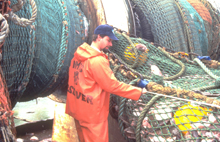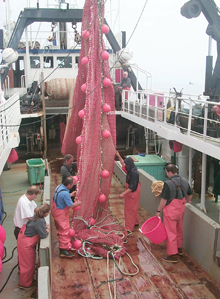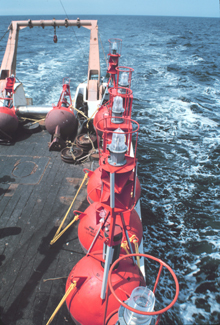Evolution of the Fisheries Science Enterprise:
1970-2007
NOAA is dedicated to the stewardship of living marine resources through science-based conservation and management and the promotion of healthy ecosystems. As a steward, NOAA conserves, protects, and manages living marine resources in a way that ensures their continuation as functioning components of marine ecosystems, affords economic opportunities, and enhances the quality of life for the American public.
- Introduction
- Policies Affect Research
- Technological Revolution
- Paradigm Shift
- Conclusion
- Works Consulted
NOAA Fisheries science has evolved in ways that are both evolutionary and revolutionary. Accordingly, the modern definition of fisheries science is far more complex than it was when NOAA's National Marine Fisheries Service was first established.

A vast NOAA Fisheries Service observer network to obtain data on directed catch and bycatch is a critical part of the ecosystem assessment program. Click image for larger view.
Current research targets the biophysical and environmental processes that influence fish populations in marine and coastal ecosystems. At the same time, scientists now wrestle with more empirical and inclusive examinations of complex regional ecosystems that include not only living resources, but also human influences. Thus, the current direction of fisheries research involves much more than the isolated study of fish biology, exploratory fishing, and gear development activities of the mid-1900s.
Over the past 37 years, NOAA has continually expanded the scope and complexity of scientific activities focused on monitoring the status and trends of U.S. and internationally-managed fishery stocks and of protected species and their habitats. This article explores this recent evolution of fisheries science within the organization.
Policy Changes Affect Fisheries Research
The 1970 National Environmental Policy Act, the 1972 Marine Mammal Protection Act, the 1973 Endangered Species Act, and the 1976 Magnuson-Stevens Fishery Conservation and Management Act drove significant changes in NOAA's National Marine Fisheries Service. These policies influenced many aspects of National Marine Fisheries Service operations, from basic science investigations to applied science programs. In particular, these acts emphasized the use of the "best available science" and the importance of independent peer review.
Based on mandates in these acts, the National Marine Fisheries Service initiated formal research of human influences on fisheries. These studies explored human influences on fisheries via the social sciences, especially economics, sociology, and anthropology. NOAA scientists also championed innovative concepts that expanded fisheries assessments from a focus on a single species, to multiple species, and, finally, to the whole ecosystem. This shift has been gradual, occurring over the past three decades.
A More Holistic View: The 1980s
In the 1980s, Large Marine Ecosystems (LMEs), which are geographically and biologically unique areas that have been designated through international agreements, provided a more holistic framework focused on five areas:
- productivity, mainly the primary productivity the LME contributes to the ecosystem
- fish and fisheries, including the status of stocks and relationships of fish to the ecosystem and the promotion of sustainable fisheries through effective stewardship
- pollution, including point sources and impacts of pollution to the ecosystem
- socioeconomics, mainly the direct and indirect economic benefits of the ecosystem to coastal communities
- governance, specifically those issues with intergovernmental governance that can affect the ecosystem.
Modern Approaches

Good information on America's fisheries is at the heart of ecosystem management. In this photo, a science crew prepares to deploy a sampling net from a NOAA research vessel. Click image for larger view.
By the 1990s, ecosystem-based research and adaptive management initiatives, such as multispecies stock assessments, determination of essential habitat, and other adaptive management approaches came into the mix. With these new approaches, today ocean and coastal resources are managed to reflect the relationship among all ecosystem components, including:
- fishery resources – the direct and indirect impact of removal of fish from the ecosystem;
- protected species – the importance of the niche that protected species fill in the ecosystem;
- predators and prey – the interrelationships within the ecosystem and impacts that any disruptions in the balance between predator and prey can have on the ecosystem;
- fisheries and their human dimensions – the social and economic benefits of the ecosystem, including recreational opportunities and discovery of new resources such as drugs from the marine ecosystem; and
- physical environment and climate – the importance of the unique physical attributes of the ecosystem and the importance that seasonal, decadal, and longer-term changes in weather, water, and climate have on the balance within the ecosystem.
The Technological Revolution
Personal computers and the Internet have changed the world. Today, a fisheries scientist sitting at a desk operates devices far more capable than the mainframe systems used by NOAA in the 1960s and 1970s. Fish stock assessments that once took a scientist all day to complete using a hand-held calculator can now be done with inexpensive computing power in seconds. Fisheries stock assessment analyses are more comprehensive and complex than they have ever been.
Assessments are a scientific, statistically based method of estimating the size of a stock based on a sampling of a portion of that stock (we don't count all of the fish then throw them back - we sample them!) Assessments are growing increasingly more complex because, while NOAA used to use single-species models, we now use multi-species models and also incorporate additional data sources, such as acoustic surveys, into the models. Because there are few technical constraints on computational power, NMFS scientists are able to include much more information in their assessments.

Sound scientific information must include data from the saltwater recreational fishing sector throughout America's coasts. Click image for larger view.
The enormous computing power available to study very large, complex fisheries stock datasets has resulted in increasingly sophisticated statistical and probability-based fish stock assessments capable of reconstructing the history of fish stocks. Assessment models now project well beyond the current status of stocks and can provide scenarios of the consequences of alternative management strategies, including the likelihood of success of any particular approach.
Technology improvements are also evident in NOAA's newest fishery survey vessels. The Oscar Dyson and Henry B. Bigelow ships, for example, are specially designed to meet international standards for very-low radiated vessel noise. These vessels also carry sophisticated mission-specific electronics and sensors. These instruments include dynamic global and ship positioning systems, state-of-the-art acoustic hydrophones for midwater fish assessments and bottom mapping, fishing gear positioning instruments including live video of trawl net performance, and automatic on-deck entry systems for capturing biological and environmental data. Real-time data streams are immediately checked to control quality, backed-up by onboard computers, and periodically transmitted shore side for preliminary analyses. None of this was possible 30 years ago.
A Paradigm Shift
Between 1970 and 2007, NOAA's National Marine Fisheries Service has integrated many disciplines into its research and management decisions and the agency has contributed to a more comprehensive and cohesive scientific view that includes fishery resources, protected species, habitats, sustainable fisheries, regional ecosystems, the environment, and climate. Not only has fisheries biology become more complex in the last 30 years, but our understanding of fundamental fish biology has also substantially improved.
Ecosystem Performance Analysis
Likewise, analyses of living ocean and coastal systems and state-of-the-art data collection efforts on, for example, life history stages and nutritional interactions, coupled with the ability to handle and process enormous amounts of information, has led to a rapidly developing and growing field that evaluates the performance of ecosystem approaches to management.
Social Science Advancements

Remote sensing is a critical source of fisheries oceanographic data. Here, the NOAA ship Albatross gets ready to deploy tethered instrument packages. Click image for larger view.
Advances in the social sciences have also contributed to this paradigm shift. NOAA social scientists have made many significant advances in behavioral modeling both of fishers and fishing fleets. They have a better understanding of how to value fisheries and the ability to perform more robust and powerful analyses of the economic and social trade-offs associated with different information levels or alternative management scenarios.
Expanding Scope
Finally, there has been a significant change in scope of research across additional disciplines. Early investigations dealt primarily with commercial fisheries and, following some spectacular population declines, significant investment in aquaculture to restore decimated fish populations. Today, the National Marine Fisheries Service researches recreational fisheries from both the biological and socioeconomic perspective and includes ecosystem, habitat, geographic, and synoptic information in their analyses. Fisheries scientists also analyze the effects of fishery management systems on humans and on society as a whole.
Conclusion
The evolutionary and revolutionary forces described here, coupled with the creation of a new and complex regulatory environment mandated by Congressional legislation in the 1970s, have created a fundamentally different reality in 2007. This has fostered a paradigm shift in the focus and practice of scientific research and reflects fundamental changes in the way society views living marine resources, sustainable fisheries, protected species, and wider ocean use. Today's society values holistic ecosystems, preservation and sustainable use, exploitation and conservation, realized benefits and realistic costs, and choices and tradeoffs.
This is a much more complex world than it was just three decades ago. Ultimately, the American public and NOAA's National Marine Fisheries Service understand that the overarching goal of the scientific enterprise is to find and implement effective conservation strategies and support social ethics to preserve the rich fishery-based ecosystems of the nation.
Works Consulted
Bakun, A. (1996). Patterns in the ocean: ocean processes and marine population dynamics. La Jolla: California Sea Grant College System.
LME Network. (2006). Large Marine Ecosystems of the World. Retrieved October 30, 2006, from: http://www.edc.uri.edu/lme/.
National Research Council. (2006). Dynamic changes in marine ecosystems: fishing, food webs, and future options. Washington, DC: National Academy Press.
National Research Council. (2004). Improving the use of the "best scientific information" standard in fisheries management. Washington, DC: National Academy Press.
National Research Council. (2003). Enabling ocean research in the 21st century: implementation of a network of ocean observatories. Washington, DC: National Academy Press.
National Research Council. (2002). Science and it's role in the National Marine Fisheries Service. Washington, DC: National Academy Press.
National Research Council. (2001). Marine protected areas: tools for sustaining ocean ecosystems. Washington, DC: National Academy Press.
National Research Council. (1999). Sustaining marine fisheries. Washington, DC: National Academy Press.
Witherell, D. (Ed.) (2004). Managing our nation's fisheries: past, present, and future. Proceedings of a conference on fisheries management in the United States. Washington, DC. November 2003.
